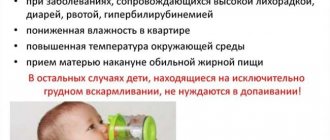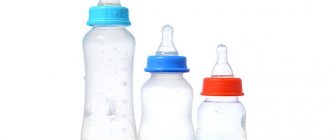Updated: 06/06/2021 16:18:59
The body of a newborn child is not yet perfect; he faces a difficult period of adaptation to the world around him. To properly care for him, you need to know the physiological characteristics of the child's body. One of these features is the absence of tears when crying. This is a normal situation that should not cause concern to the mother. From our article, young parents will learn at what months the first tears appear in a newborn, and what to do if this does not happen.
Why does a newborn have no tears?
During intrauterine development, the child develops in the amniotic fluid, which constantly wets the mucous membrane of the eyes. It turns out that it performs the function of tears. Research in recent years has shown that the baby in the womb experiences emotions, but does not produce tear fluid. Their function is performed by amniotic fluid, which maintains the health of the fetal eyes.
After birth, the newborn has no tears, even if he cries and experiences negative emotions. This is a normal phenomenon, which is due to the fact that the baby’s tear ducts are still closed by a mucous plug. It acts as a kind of valve that blocks the exit of tears from the conjunctival cavity.
The baby’s body immediately after birth is covered with plaque, which protects the mucous membranes and skin of the newborn from the penetration of pathogenic microorganisms. The same plaque is present in the tear ducts and on the conjunctiva of the eyes. It forms a jelly-like plug, which after some time comes out and opens the channels for tears.
Why can there be no tears for a long time?
You need to constantly remain attentive to the baby’s health condition. Sometimes the baby is at a normal age for tears to appear, but they do not flow. This may indicate that the tear duct is clogged, and this situation is not uncommon among infants. Tears are produced but cannot come out, even when babies cry. They accumulate inside, which leads to gluing of the eyes.
Sometimes tears may flow, but the baby does not cry. This also suggests that the plug in the tear ducts has not yet dissolved. In addition, the following additional reasons are identified that affect the opening of passages:
- narrow passages;
- underdevelopment of function;
- serous disease;
- inflammatory process.
When the first tears appear
3-4 weeks after the baby is born, his tear ducts mature enough to form tears. After the baby is born, the mucus plug gradually decreases in size and is removed on its own. Typically this period takes 1.5 months. If during this time the baby does not cry, then this is not a cause for concern and does not require seeing a doctor. As a rule, tears appear on the 30-45th day of a baby’s life. At this time, you should not stimulate the removal of the mucus plug on your own. This can cause inflammation of the tear duct.
Interesting! A child’s first tears can be either abundant or scanty, just a couple of drops. For the first time, any amount of tears is normal.
When the tears come
During the first few weeks, the closing plugs dissolve, and by 1.5-3 months, tears begin to flow into the eyes.
The day when the baby starts to cry, the mother will remember for a long time. It’s so unexpected – there were no tears, and suddenly there are. For some babies, they run in streams down their cheeks; for the first time, it’s a touching sight. For other children, one or two drops appear, and for the first time this is enough.
If by a certain point the baby does not have tears when crying, then most likely his tear ducts are clogged. You need to visit an ophthalmologist
If a newborn has tears immediately, is this normal?
The appearance of tears in the first two weeks after the birth of a child is atypical and is considered a deviation. Normally, at least 14 days should pass before the newborn starts crying. If he has tear fluid ahead of schedule, this is a sign of the following problems:
- Infectious eye lesions. For this reason, the newborn not only has watery eyes, but also reddened and swollen eyelids.
- A blocked tear duct, which in some cases leads to infections.
- Inflammation that usually occurs with conjunctivitis. This disease is manifested by swelling and redness of the eyes.
Dacryocystitis, what kind of disease is it?
Many parents ask doctors the question: “When does a newborn start crying?” Everything is quite individual. It often happens that a baby cries crocodile tears from the first minutes of life. But if this is not the case, don't worry. There is time to wait.
The alarm should be sounded when the baby turns 2 months old, and the tear ducts have not started to work. In this case, the pediatrician will recommend contacting an ophthalmologist, a doctor who directly deals with eye problems.
Perhaps the baby will be diagnosed with dacryocystitis. The disease may be congenital. It is treatable. But the sooner we understand and solve the problem, the better.
So, when do newborns cry? Ideally, this can happen in the first seconds of life. The process is quite clear and logical. When the fetus is in the mother's belly, the nasolacrimal ducts are closed with a special film. It prevents amniotic fluid from entering the baby's lungs. As soon as the baby takes his first breath after birth, the film should break. But this doesn't always happen.
If the tears don't flow
It happens that after 1.5 months the newborn’s tear ducts do not open on their own. This happens for the following reasons:
- the lacrimal canals are not ripe for independent work;
- excessively narrow tear ducts;
- weak functionality of the lacrimal gland;
- thick jelly-like plug;
- pathological process.
If it happens that the tear ducts do not open in a timely manner, this is often a sign of dacryocystitis. Particularly dangerous is the situation when the baby’s tears appeared and then disappeared. This moment requires observation, perhaps it is a sign of dehydration.
Obstruction of the lacrimal ducts
Sometimes newborns experience obstruction of the lacrimal ducts. The reason for this condition lies in congenital pathology, obstruction of the nasolacrimal duct. This canal contains a membrane that should burst at the time of birth. The European Medical Center found that children born prematurely are susceptible to this pathology. Their membrane does not have time to rupture at the time of birth due to immaturity.
Research from the European Medical Center has shown that the problem of tear duct obstruction occurs in 30% of newborns. Most often boys suffer from this. Such children have different behavior, they are restless and capricious. They have red eyelids and droopy eyes.
This problem cannot be dealt with using folk methods; ordinary hygiene measures will not help. You need to consult a doctor to determine further tactics. The baby needs to restore tear production as soon as possible. Because tears perform a protective function. Stagnation of tears causes inflammatory processes that are dangerous for the child.
Eye care
Until the cleansing lacrimation of the infant has improved, this function is performed by the parents. Every day, during morning and evening hygiene procedures, carefully examine the whole baby, including his eyes.
Important : use potassium permanganate with extreme caution, carefully filter and settle the solution. One inconspicuous grain of potassium permanganate can cause big problems for a small eye. Be careful and careful.
While washing your face, wipe your eyes with warm boiled water. Use a cotton swab dipped in warm water to wipe your eyes from your temple to the bridge of your nose. Use a separate cotton swab for each eye.
On the recommendation of a pediatrician or ophthalmologist, you can wash your eyes with herbal decoctions, for example, chamomile decoction. Pour a glass of boiling water over a teaspoon of chopped herb, leave for half an hour, cool to room temperature. When using decoctions you prepare yourself, strain them carefully and do not allow solid particles to get into the solution.
If the need arises, take a little disinfectant solution of furatsilin 1:5000 or a weak, almost transparent solution of potassium permanganate on a cotton swab.
After birth, the baby must be shown to an ophthalmologist several times - at 1 month, at 6 months, at a year and at three years. The doctor will monitor the condition of the baby’s eyes and vision, recommend preventive measures or prescribe treatment if he discovers any problem.
When to see a doctor
If the baby is less than a month old and has not started to cry, this is a normal situation that should not alarm parents. You should contact a pediatric ophthalmologist in the following cases:
- if tears have not appeared after two months of the child’s life;
- if tears appear in only one eye;
- if, simultaneously with the absence of tears, there are signs of infectious processes, swollen eyelids, reddened eyes, purulent discharge;
- there is clouding of the eyes.
We carry out diagnostics
If parents are concerned about the question of what time tears appear in newborns, an experienced doctor does not specify specific dates. But by 2 months, the baby’s tear ducts should begin to work. If this does not happen, the ophthalmologist must conduct a thorough diagnosis. When arriving for the procedure, parents should be prepared for the following manipulations that will be performed on the baby:
- Collargol solution is instilled into the lacrimal canal. This special liquid is colored red.
- A cotton swab is inserted into the nasal cavity.
- Next, the doctor records the time until the substance stains the tampon. Normally, the process should not take more than 5 minutes.
- If 10 minutes or more have passed, the baby has problems with the patency of the tear duct.
There are difficult cases, then an x-ray is indispensable.
What should parents do before their newborn starts crying?
A newborn needs careful care and hygiene of all organs. For normal functioning, the baby's eyes must be moist. Tears regulate the control of moisture in the mucous membrane of the eyes, thereby protecting them from irritation and infections. While the baby's tear ducts are covered with a mucous film, he is most susceptible to bacterial and viral infections. Daily eye hygiene will help avoid this.
Eye treatment for infants is carried out twice a day, in the morning after waking up and before going to bed at night. The second hygiene measures should be carried out after the bath and before feeding. For the procedure you should prepare:
- sterile cotton balls;
- warm boiled water, cooled to room temperature;
- sterile gauze.
When treating your eyes, you should not use non-sterile cotton pads.
How to wash your eyes
Before treating the eyes of a newborn with an open tear duct, parents should wash their hands thoroughly to avoid further infection. This is a simple procedure that requires the following steps:
- Wash your hands.
- Soak cotton pads in the warm solution and squeeze out excess water thoroughly.
- Washing is carried out along the eyelashes from the outer edge of the eyes to the inner.
- Blot the child's eyes with sterile gauze to remove excess moisture.
- Do the same steps with the next eye.
Do not use the same cotton ball and gauze to treat both eyes. As a hygienic solution you can use:
- Chamomile infusion. For 1 cup of boiling water, take 1 tsp. chamomile flowers, leave for 2 hours, strain, judge. It can then be used to wash the eyes.
- Furacilin solution. Dissolve one tablet in 1 glass of warm boiled water.
- Ready-made saline solution.
Never use breast milk to wash your baby's eyes. This increases the risk of infection entering the baby’s eyes, which are already not protected by tear fluid.
When to expect tears?
Immediately after birth, the baby's tear ducts are still clogged, which explains the lack of secretion from them.
From the first minutes of birth, the baby begins to cry, but the parents still do not see the tears. The whole point is that the child must adapt to the new environment. The process of resorption of the gelatin-like film in the baby's tear ducts began immediately after birth, but it will take more than one week to complete.
Normal for the appearance of tears
According to doctors, full dilation begins from the end of 1 month to the middle of the second. Therefore, mothers may notice the first tears in babies either after 3 weeks or a little later, and this is the norm for such children. The situation suggests that each baby develops individually, and lacrimation will not begin to appear in everyone at the same time.
Parents should know that upon reaching the required age, the baby’s tears will be released synchronously from both eyes at once. There may be many of them at once or, conversely, the number of tears will be minimal. But both options are normal for babies aged one or two months. If the baby is crying, and tears appear only from one eye, it means that the lacrimal canal is not fulfilling its functions. There may be several reasons for the malfunction; to find out, you need to seek help from an ophthalmologist.
Daily care
At first, it is important to pay attention to washing the baby’s vision organs.
During the period of cork resorption, hygiene procedures are very important. Rinsing your baby's eyes in the morning and evening will help speed up the process of the film disappearing. For cleansing, a chamomile solution is suitable, which is brewed according to the following recipe:
- For 1 tbsp. l. dried flowers you will need 250 ml of boiling water.
- Chamomile is poured and infused for half an hour.
- Use a cotton swab soaked in the broth that has cooled to room temperature to wipe the eyes, from the outer corner to the inner one.
What to do if there is obstruction of the tear ducts
If the child does not have tears within two months, the parents observe reddened eyelids, sticky eyes, you should seek advice from a pediatric ophthalmologist. The doctor will perform a test to determine whether the tear duct is blocked. To do this, drop a solution of furatsilin into the child’s eyes and insert cotton pads into the child’s nose. If the turundas remain uncolored, then the fluid has not left the eyes, the reason lies in the blockage of the tear ducts.
Back in the 20th century, such children underwent bougienage - a surgical intervention during which the nasolacrimal duct is cut. Today, medicine offers parents to solve this issue using other, more gentle methods, using a special massage. Usually massage helps to cope with the problem. In a baby by 6 months, the obstruction of the lacrimal duct is eliminated on its own. Only in 2% of cases does bougienage have to be done.
During the massage, parents need to use careful movements to massage the area of the inner eye, just below the tubercle; do not apply too much pressure. The procedure lasts about 2 minutes on one eye. But, during the day it must be repeated 10 times. A young mother will be able to cope with the task on her own. To do this, she needs to perform the following steps:
- Wash your hands with antibacterial soap.
- Take a sterile cotton ball.
- Gently press on the clouds of the inner corner of the eye.
- Repeat the same movements for the second eye.
During the massage, pressure is applied to the tear fluid that has accumulated in the tear duct. The procedure helps to burst the membrane, thus opening the way for tears. Simultaneously with the massage, the doctor prescribes special drops that ensure the dissolution of the mucous plug in the tear duct.
Usually massage helps to cope with the problem. After a few days, a gradual leakage of tears occurs. Typically, blockage of the tear duct occurs in one eye, but the area of both eyes needs to be massaged. Because, as practice has shown, after treating the first canal, the problem may appear on the second.
Hygiene during massage
During massage, hygiene procedures are especially important, since the risk of infection in the child’s eye increases. The famous pediatrician Komarovsky gives the following advice:
- Remove excess fluid from the eye with a sterile cotton swab.
- If purulent discharge accumulates in a newborn, then it is necessary to wash the eyes with furatsilin. To do this, you need to dilute a furatsilin tablet in 1 glass of warm boiled water.
- If the fluid in the eye is clear, then rinsing is done with saline solution.
If there is no saline solution in the house, but you need to do a rinse, then you can prepare it yourself. For 1 glass of warm boiled water, take ½ tsp. salt. Mix everything well.
Bougienage
If massage does not help, then bougienage is performed under local anesthesia. During the operation, the doctor uses a thin probe to cut through the membrane. After this manipulation, an antibiotic is instilled into the child’s eyes to relieve inflammation and prevent the development of an infectious process. Otherwise, an abscess of the lacrimal canal may develop. If parents strictly follow all the doctor’s recommendations, then within a month there will be no trace left of the obstruction of the lacrimal duct.
Normally, a baby does not cry immediately after birth. The tear duct opens gradually during the first 3-4 weeks of his life. If there are no tears after 2 months, then you need to visit a pediatric ophthalmologist, who will conduct diagnostics and prescribe therapy to dissolve the tear plug.
How can it be treated?
In order for the secretion of these glands to be released normally, it is important to give the child a special massage.
In modern medicine, several methods are used to restore the function of tear secretion:
- Medicinal drops are used to dissolve the plug.
- A special massage is prescribed.
- The eyes are washed with herbal decoctions, that is, folk recipes are used.
- The tear duct is probed and washed.
Surgical intervention in a situation where the baby does not cry is a last resort. Most often, therapeutic massage helps correct the situation. The first time it will be carried out by a doctor, and then the mother will cope on her own. Basic requirements for massage:
- Do with clean hands using a cotton pad.
- Using circular movements, knead the tubercle under the inner corner of the eye.
- Carry out the procedure 5 to 10 times a day.
A few days after forced stimulation of the tear duct, the accumulated tears will begin to move and push through the plug. The final result will appear in 3-5 days through the baby’s tears. During this period, it is important to carefully wash all opaque accumulations inside the corner of the eye with a solution of Furacilin or chamomile decoction and wipe with a clean cotton pad.











